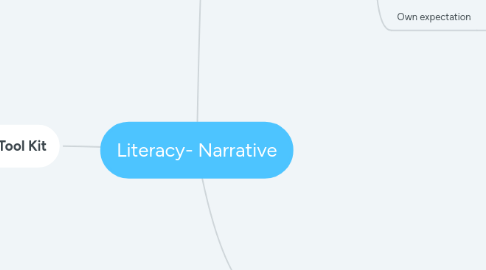
1. Genre Tool Kit
1.1. Genre Features
1.1.1. 1st-person story
1.1.2. illiteracy to literacy
1.1.3. Connection between power and literacy
1.1.4. Resembles Professional Examples of Literacy from class textbook
1.2. Audience
1.2.1. Engaging
1.2.2. Interesting
1.2.3. Moving
1.2.3.1. Pathos
1.2.4. Memorable for readers: those who are interested about how the author gained power through literacy
1.2.5. Address Audience
1.2.5.1. Different backgroung
1.2.5.2. Diverse linguistic backgrounds
1.2.5.3. Very Scholarly
1.3. Editing & Formatting
1.3.1. no grammatical error
1.3.2. formatted perfectly
1.3.2.1. double spaced
1.3.2.2. 12 font
1.3.2.3. time new roman
1.4. Organization & Detail
1.4.1. fluent
1.4.2. very easy to read
1.4.3. time chronology
1.4.4. details
1.4.4.1. anecdotes
1.4.4.2. descriptions
1.5. Purpose
1.5.1. Teaches readers
1.5.2. exciting
1.5.3. original
1.5.4. new about power/literacy
2. Literacy Sponsors
2.1. The Types
2.1.1. Positive
2.1.1.1. Attended a public school
2.1.1.1.1. Different Perspective
2.1.1.2. Going to USA
2.1.1.2.1. Got Many Resources
2.1.2. Negative
2.1.2.1. Stagnation
2.1.2.1.1. Grades
2.1.2.1.2. Standardized Testings
2.1.2.1.3. English was not first Language
3. Philosophy Class
3.1. Learning Environment
3.1.1. Philosophy
3.1.1.1. Abstract Concepts
3.1.1.1.1. Metaphysics
3.1.1.1.2. Free Will vs. Determinism
3.1.1.2. Was not God vs Everyone
3.1.1.3. Discussion
3.1.1.3.1. Talking
3.1.1.3.2. Logical Thinking/Reasoning
3.1.2. Standard
3.1.2.1. Structured Learning
3.1.2.1.1. Expectations
3.1.2.2. Was not comfortable to share ideas
3.1.2.2.1. Restricted sharing of ideas
3.1.2.3. Was never ope to discussion
3.1.2.4. Obey or pay the price
3.1.2.4.1. Don't follow
3.2. Own expectation
3.2.1. I was going to drop the class
3.2.1.1. Became more open-minded
